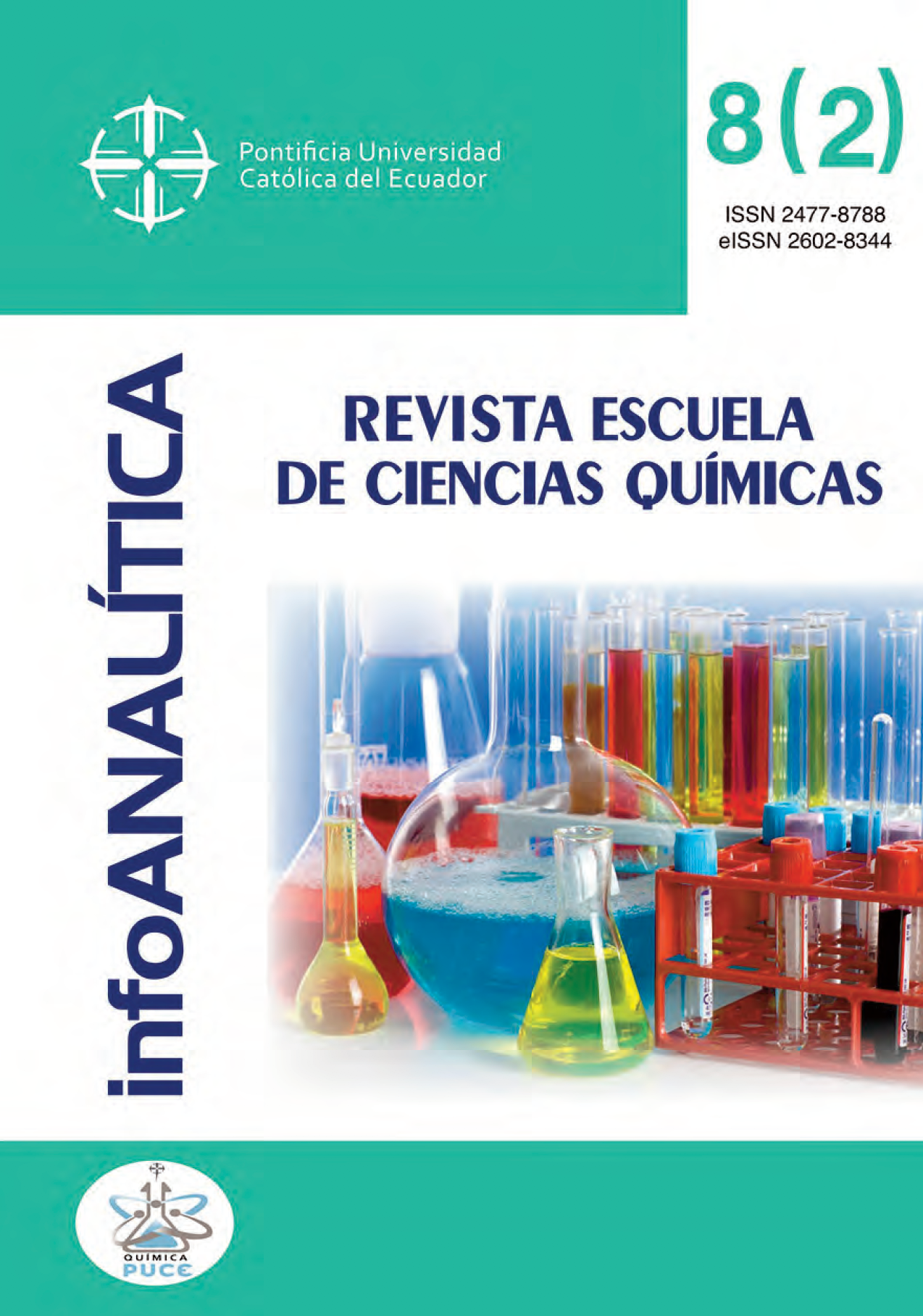Monitoring of anaerobic waste digestion at Quito slaughterhouse
Main Article Content
Abstract
Organic matter from slaughterhouses can be used through anaerobic digestion to produce biogas and a nutrient-rich fertilizer. Monitoring the concentration of methane, propane, and butane are relevant parameters that show the efficiency of digestion. In the present study, a methodology for the measurement of these hydrocarbons was developed, using Fourier transform infrared spectrophotometry (FTIR) and the assistance of chemical-quantum calculations, which allowed the assignment of absorption bands of each hydrocarbon in biogas. The quantification limits were 0.36 %V/V for propane and butane and 1.47 %V/V for methane. Digestion tests were carried out with waste from the municipal slaughter center of the Metropolitan District of Quito, obtaining that a mixture of rumen and bovine manure, subjected to 50 °C, generated enriched biogas up to 65.4 %V/V after 15 days of digestion. Additionally, solid and liquid digestate produced met with international regulations for possible application in the soil. The results demonstrate the potential of the digestion monitoring method and the possible transformation of litter waste into a renewable energy source.
Downloads
Article Details
- The authors agree to respect the academic information of other authors, and to assign the copyrights to the journal infoANALÍTICA, so that the article can be edited, published and distributed.
- The content of the scientific articles and the publications that appear in the journal is the exclusive responsibility of their authors. The distribution of the articles published in the infoANALÍTICA Journal is done under a Creative Commons Reconocimiento-CompartirIgual 4.0 Internacional License.
References
Accettola, F., Guebitz, G. M., & Schoeftner, R. (2008). Siloxane removal from biogas by biofiltration: biodegradation studies. Clean Technologies and Environmental Policy, 10(2), 211–218. https://doi.org/10.1007/s10098-007-0141-4
Afazeli, H., Jafari, A., Rafiee, S., & Nosrati, M. (2014). An investigation of biogas production potential from livestock and slaughterhouse wastes. Renewable and Sustainable Energy Reviews, 34, 380–386. https://doi.org/10.1016/j.rser.2014.03.016
Agrocalidad. (2013). Manual de procedimientos para la inspeccion y habilitacion de mataderos (Resolución DAJ-20134B4-0201.0247). http://www.agrocalidad.gob.ec/wp-content/uploads/2015/07/Manual-procedimiento-inspeccion-y-habilitacion-Mataderos-DAJ-20134B4-0201.0247.pdf
Agrocalidad. (2018). Listado de mataderos bajo inspección oficial - MABIO. http://www.agrocalidad.gob.ec/documentos/inocuidad/listado-de-mataderos-mabio-a-abril-2018.pdf
Bustillo-Lecompte, C. F., & Mehrvar, M. (2015). Slaughterhouse wastewater characteristics, treatment, and management in the meat processing industry: A review on trends and advances. Journal of Environmental Management, 161, 287–302. https://doi.org/10.1016/j.jenvman.2015.07.008
CFR-US. (1993). Standards for the use or disponsal of sewage sludge. https://www.law.cornell.edu/cfr/text/40/part-503
Comeford, J. J., & Gould, J. H. (1961). Infrared spectra of solid hydrocarbons at very low temperatures. Journal of Molecular Spectroscopy, 5(1–6), 474–481. https://doi.org/10.1016/0022-2852(61)90110-2
Djeffal, S., Mamache, B., Elgroud, R., Hireche, S., & Bouaziz, O. (2018). Prevalence and risk factors for Salmonella spp. contamination in broiler chicken farms and slaughterhouses in the northeast of Algeria. Veterinary World, 11(8), 1102–1108. https://doi.org/10.14202/vetworld.2018.1102-1108
FAO. (2018). Food Outlook. Biannual Report on Global Food Markets. http://www.fao.org/3/ca2320en/CA2320EN.pdf
Hagos, K., Zong, J., Li, D., Liu, C., & Lu, X. (2017). Anaerobic co-digestion process for biogas production: Progress, challenges and perspectives. Renewable and Sustainable Energy Reviews, 76, 1485–1496. https://doi.org/10.1016/j.rser.2016.11.184
Hepburn, C. A., Vale, P., Brown, A. S., Simms, N. J., & McAdam, E. J. (2015). Development of on-line FTIR spectroscopy for siloxane detection in biogas to enhance carbon contactor management. Talanta, 141, 128–136. https://doi.org/10.1016/j.talanta.2015.03.063
Honeycutt, W. T., Ley, M. T., & Materer, N. F. (2019). Precision and Limits of Detection for Selected Commercially Available, Low-Cost Carbon Dioxide and Methane Gas Sensors. Sensors, 19(14), 3157. https://doi.org/10.3390/s19143157
Instituto Nacional de Estadísticas y Censos. (2018). Estadísticas Agropecuarias. ESPAC 2018. http://www.ecuadorencifras.gob.ec/estadisticas-agropecuarias-2/
Irikura, K. K., Johnson, R. D., & Kacker, R. N. (2005). Uncertainties in Scaling Factors for ab Initio Vibrational Frequencies. The Journal of Physical Chemistry A, 109(37), 8430–8437. https://doi.org/10.1021/jp052793n
Kozdruń, W., Czekaj, H., & Styś, N. (2015). Avian zoonoses – a review. Bulletin of the Veterinary Institute in Pulawy, 59(2), 171–178. https://doi.org/10.1515/bvip-2015-0026
Lagrange, B. (1979). Biomethane. Principes, Techniques, Utilisation. Vol.2 (Edisud (ed.)).
Maroto, A., Riu, J., Boqué, R., & Xavier Rius, F. (1999). Estimating uncertainties of analytical results using information from the validation process. Analytica Chimica Acta, 391(2), 173–185. https://doi.org/10.1016/S0003-2670(99)00111-7
Miller, J., Miller, J., & Miller, L. (2018). Statistics and Chemometrics for Analytical Chemistry (7th ed.). Harlow: Pearson Education Limited.
MINENERGIA, PNUD, FAO, & GEF. (2011). Manual de Biogás. http://www.fao.org/3/as400s/as400s.pdf
Nkoa, R. (2014). Agricultural benefits and environmental risks of soil fertilization with anaerobic digestates: a review. Agronomy for Sustainable Development, 34(2), 473–492. https://doi.org/10.1007/s13593-013-0196-z
Pele, L., Šebek, J., Potma, E. O., & Benny Gerber, R. (2011). Raman and IR spectra of butane: Anharmonic calculations and interpretation of room temperature spectra. Chemical Physics Letters, 515(1–3), 7–12. https://doi.org/10.1016/j.cplett.2011.09.015
Peñafiel, W., & Ticona, D. (2015). Ruminal De Bovino - Matadero Municipal De La Paz. Revista de Investigación e Innovación Agropecuaria y de Recursos Naturales, 87–90.
Pham, C. H., Triolo, J. M., Cu, T. T. T., Pedersen, L., & Sommer, S. G. (2013). Validation and Recommendation of Methods to Measure Biogas Production Potential of Animal Manure. Asian-Australasian Journal of Animal Sciences, 26(6), 864–873. https://doi.org/10.5713/ajas.2012.12623
Reinelt, T., Delre, A., Westerkamp, T., Holmgren, M. A., Liebetrau, J., & Scheutz, C. (2017). Comparative use of different emission measurement approaches to determine methane emissions from a biogas plant. Waste Management, 68, 173–185. https://doi.org/10.1016/j.wasman.2017.05.053
Soares, T. C. S., Gottschalk, M., Lacouture, S., Megid, J., Ribolla, P. E. M., Pantoja, J. C. de F., & Paes, A. C. (2015). Streptococcus suis in employees and the environment of swine slaughterhouses in São Paulo, Brazil: Occurrence, risk factors, serotype distribution, and antimicrobial susceptibility. Canadian Journal of Veterinary Research = Revue Canadienne de Recherche Veterinaire, 79(4), 279–284. http://www.ncbi.nlm.nih.gov/pubmed/26424907
Tezel, U., Tandukar, M., & Pavlostathis, S. G. (2011). Anaerobic Biotreatment of Municipal Sewage Sludge. In Comprehensive Biotechnology (pp. 447–461). Elsevier. https://doi.org/10.1016/B978-0-08-088504-9.00329-9
Varnero-Moreno, M. T. (2011). Manual de Biogás. http://www.fao.org/3/as400s/as400s.pdf
Walkley, A., & Black, I. A. (1934). An Examination of the Degtjareff Method for Determining Soil Organic Matter, and a Proposed Modification of the Chromic Acid Titration Method. Soil Science, 37(1), 29–38. https://doi.org/10.1097/00010694-193401000-00003

